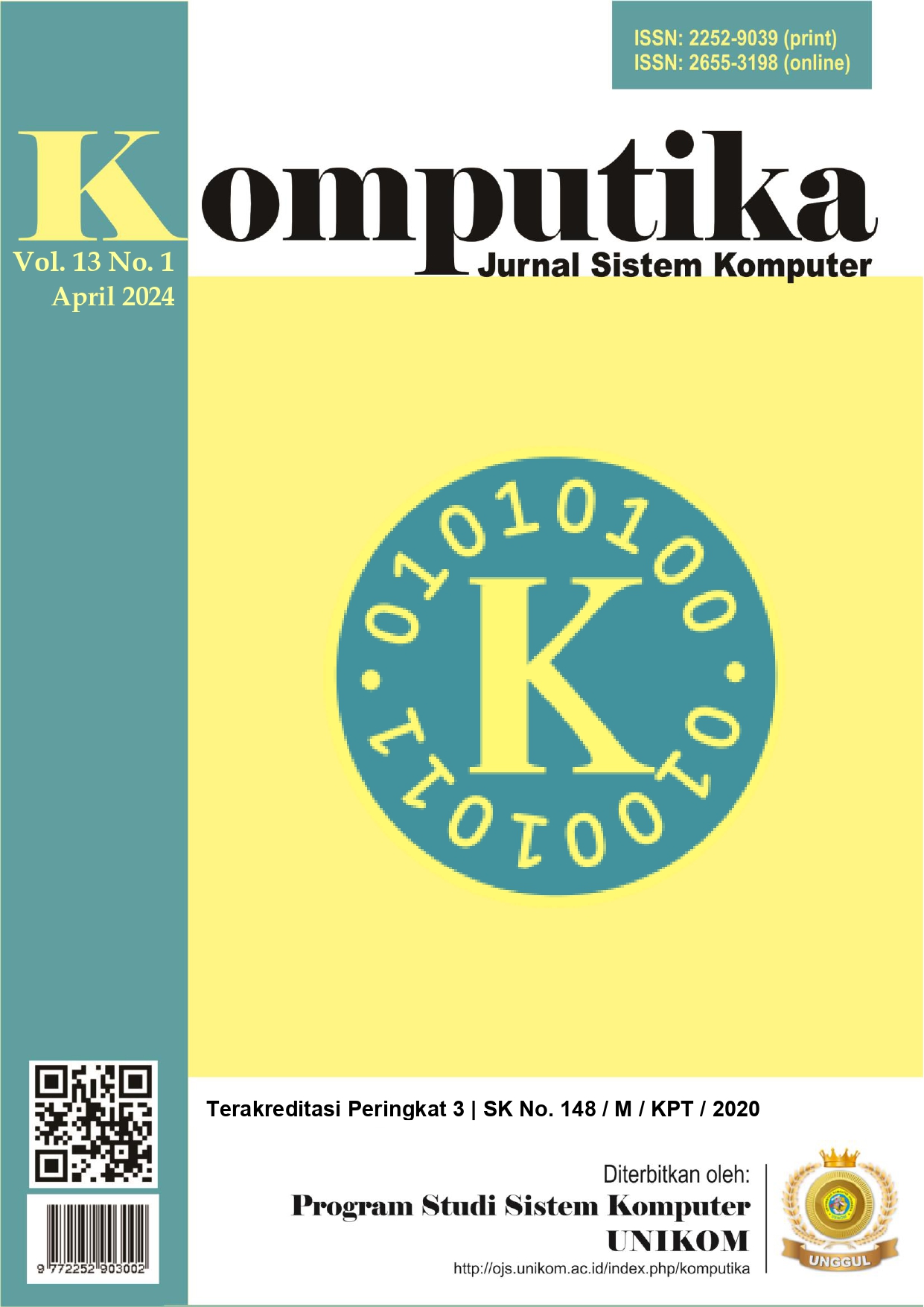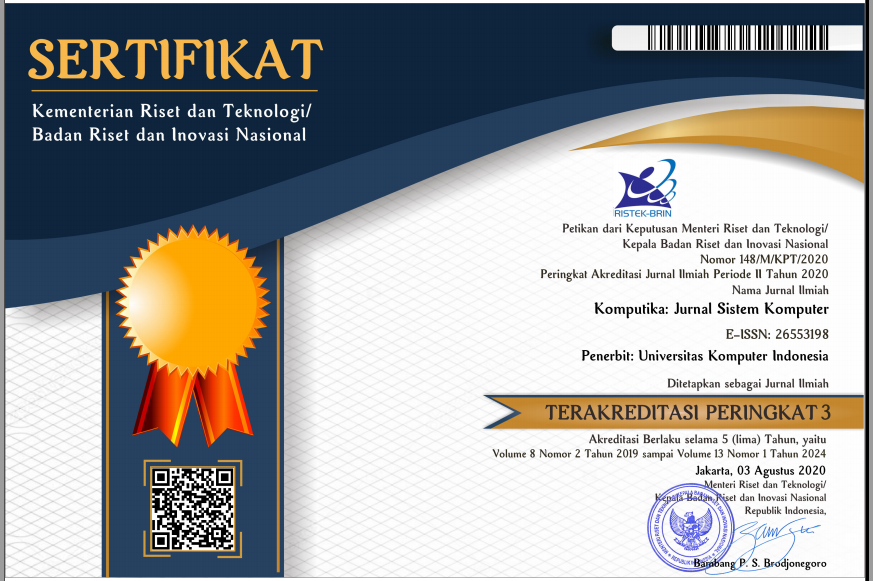Prototipe Sederhana Sistem Deteksi Kriminal Berbasis Internet Of Things Menggunakan Teknologi YOLOv5
DOI:
https://doi.org/10.34010/komputika.v13i1.12217Abstract
Crime is any action or thing carried out by an individual, group or community that violates the law or is a criminal act, which disturbs social balance or stability in society. One of the tools used to monitor security in various places such as homes, offices and other public places is Closed-Circuit Television (CCTV). However, even though many CCTVs have been installed, many crimes still occur due to limitations in monitoring and supervision by security officers. Therefore, developing a crime detection system on CCTV using deep learning methods is considered important to increase security and reduce crime rates. The aim of a criminal detection system is to increase security and prevent criminal acts in a certain area or place. The technology used is YOLOv5 and is supported by Internet of Things-based hardware. The system succeeded in detecting violence objects 92% of the time and robbery 91% of the time in initial testing without background. In the second background test, the system succeeded in detecting violence objects 93% of the time and robbery 53% of the time. The system succeeded in detecting violence objects 91% of the time and robbery 83% of the time in real-time testing.
References
R. Khairani and Y. Ariesa, “Analisis Faktor-Faktor Yang Mempengaruhi Tingkat Kriminalitas Sumatera Utara (Pendekatan Ekonomi),” J. Kaji. Ekon. dan Kebijak. Publik, vol. 4, no. 2, pp. 99–110, 2019.
S. Rahmalia, Ariusni, and M. Triani, “Pengaruh Tingkat Pendidikan, Pengangguran, dan Kemiskinan Terhadap Kriminalitas di Indonesia,” J. Kaji. Ekon. dan Pembang., vol. 1, no. 1, pp. 21–36, 2019.
R. I. Sari, “Hubungan Pengangguran, Pendidikan dan Distribusi Pendapatan terhadap Angka Kriminalitas di Sulawesi Selatan Menggunakan Analisis Regresi Data Panel,” 2018, [Online]. Available: http://repositori.uin-alauddin.ac.id/12500/1/HUBUNGAN PENGANGGURAN%2C PENDIDIKAN DAN DISTRIBUSI PENDAPATAN TERHADAP ANGKA KRIMINALITAS DI SULAWESI SELATAN MENGGUNAKAN A~1.pdf.
R. M. Sabiq and N. C. Apsari, “Dampak Pengangguran Terhadap Tindakan Kriminal Ditinjau Dari Perspektif Konflik,” J. Kolaborasi Resolusi Konflik, vol. 3, no. 1, pp. 51–64, 2021, doi: 10.24198/jkrk.v3i1.31973.
R. M. Sabiq and N. Nurwati, “Pengaruh Kepadatan Penduduk Terhadap Tindakan Kriminal,” J. Kolaborasi Resolusi Konflik, vol. 3, no. 2, pp. 161–167, 2021, doi: 10.24198/jkrk.v3i2.35149.
Badan Pusat Statistik, “Statistik Kriminal Tahun 2023,” Badan Pus. Stat., vol. 14, p. 209, 2023, [Online]. Available: https://www.bps.go.id/id/publication/2023/12/12/5edba2b0fe5429a0f232c736/statistik-kriminal-2023.html.
Gega Ryani Cahya Kurnia B. P, “Peran Kamera Pengawas Closed-Circuit Television (CCTV) Dalam Kontra Terorisme,” J. Lemb. Ketahanan Nas. Republik Indones., vol. 9, no. 4, pp. 100–116, 2020.
C. S. Sung and J. Y. Park, “Design of an intelligent video surveillance system for crime prevention: applying deep learning technology,” Multimed. Tools Appl., vol. 80, no. 26–27, pp. 34297–34309, 2021, doi: 10.1007/s11042-021-10809-z.
V. C. Maha Vishnu, M. Rajalakshmi, and R. Nedunchezhian, “Intelligent traffic video surveillance and accident detection system with dynamic traffic signal control,” Cluster Comput., vol. 21, no. 1, pp. 135–147, 2018, doi: 10.1007/s10586-017-0974-5.
J. Xu, “A deep learning approach to building an intelligent video surveillance system,” Multimed. Tools Appl., vol. 80, no. 4, pp. 5495–5515, 2021.
A. Setiawan and A. Irma Purnamasari, “Pengembangan Passive Infrared Sensor (PIR) HC-SR501 dengan Microcontrollers ESP32-CAM Berbasiskan Internet of Things (IoT) dan Smart Home sebagai Deteksi Gerak untuk Keamanan Perumahan,” Prosisiding Semin. Nas. SISFOTEK (Sistem Inf. dan Teknol. Informasi), vol. 3, no. 1, pp. 148–154, 2019, [Online]. Available: http://seminar.iaii.or.id/index.php/SISFOTEK/article/view/118.
J. P. Sagala, I. Candradewi, and A. Harjoko, “Penggunaan Deteksi Gerak untuk Pengurangan Ukuran Data Rekaman Video Kamera CCTV,” IJEIS (Indonesian J. Electron. Instrum. Syst., vol. 10, no. 1, p. 99, 2020, doi: 10.22146/ijeis.35983.
S. Ahmed, M. T. Bhatti, M. G. Khan, B. Lövström, and M. Shahid, “Development and Optimization of Deep Learning Models for Weapon Detection in Surveillance Videos,” Appl. Sci., vol. 12, no. 12, 2022, doi: 10.3390/app12125772.
A. Castillo, S. Tabik, F. Pérez, R. Olmos, and F. Herrera, “Brightness guided preprocessing for automatic cold steel weapon detection in surveillance videos with deep learning,” Neurocomputing, vol. 330, pp. 151–161, 2019, doi: 10.1016/j.neucom.2018.10.076.
T. A. Kumar, R. Rajmohan, M. Pavithra, S. A. Ajagbe, R. Hodhod, and T. Gaber, “Automatic Face Mask Detection System in Public Transportation in Smart Cities Using IoT and Deep Learning,” Electron., vol. 11, no. 6, 2022, doi: 10.3390/electronics11060904.
J. Ieamsaard, S. N. Charoensook, and S. Yammen, “Deep Learning-based Face Mask Detection Using YoloV5,” Proceeding 2021 9th Int. Electr. Eng. Congr. iEECON 2021, pp. 428–431, 2021, doi: 10.1109/iEECON51072.2021.9440346.



















